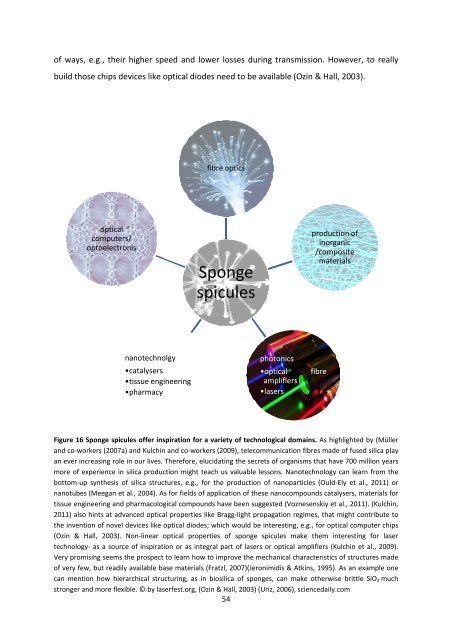MASTER THESIS Biomimetic potential of sponge ... - IAP/TU Wien
MASTER THESIS Biomimetic potential of sponge ... - IAP/TU Wien
MASTER THESIS Biomimetic potential of sponge ... - IAP/TU Wien
You also want an ePaper? Increase the reach of your titles
YUMPU automatically turns print PDFs into web optimized ePapers that Google loves.
<strong>of</strong> ways, e.g., their higher speed and lower losses during transmission. However, to really<br />
build those chips devices like optical diodes need to be available (Ozin & Hall, 2003).<br />
fibre optics<br />
optical<br />
computers/<br />
optoelectronis<br />
Sponge<br />
spicules<br />
production <strong>of</strong><br />
inorganic<br />
/composite<br />
materials<br />
nanotechnolgy<br />
•catalysers<br />
•tissue engineering<br />
•pharmacy<br />
photonics<br />
•optical<br />
amplifiers<br />
•lasers<br />
fibre<br />
Figure 16 Sponge spicules <strong>of</strong>fer fer inspiration for a variety <strong>of</strong> technological domains. As highlighted by (Müller<br />
and co-workers (2007a) and Kulchin and co-workers (2009), telecommunication fibres made <strong>of</strong> fused silica play<br />
an ever increasing role in our lives. Therefore, elucidating the secrets <strong>of</strong> organisms that have 700 million years<br />
more <strong>of</strong> experience in silica production might teach us valuable lessons. Nanotechnology can learn from the<br />
bottom-up synthesis <strong>of</strong> silica structures, e.g., for the production <strong>of</strong> nanoparticles (Ould-Ely et al., 2011) or<br />
nanotubes (Meegan et al., 2004). As for fields <strong>of</strong> application <strong>of</strong> these nanocompounds catalysers, materials for<br />
tissue engineering and pharmacological compounds have been suggested (Voznesenskiy et al., 2011). (Kulchin,<br />
2011) also hints at advanced optical properties like Bragg-light propagation regimes, that might contribute to<br />
the invention <strong>of</strong> novel devices like optical diodes; which would be interesting, e.g., for optical computer chips<br />
(Ozin & Hall, 2003). Non-linear optical properties <strong>of</strong> <strong>sponge</strong> spicules make them interesting for laser<br />
technology- as a source <strong>of</strong> inspiration or as integral part <strong>of</strong> lasers or optical amplifiers<br />
(Kulchin et al., 2009).<br />
Very promising seems the prospect to learn how to improve the mechanical characteristics tics <strong>of</strong> structures made<br />
<strong>of</strong> very few, but readily available base materials (Fratzl, 2007)(Jeronimidis & Atkins, 1995). As an example one<br />
can mention how hierarchical structuring, as in biosilica ica <strong>of</strong> <strong>sponge</strong>s, can make otherwise brittle SiO 2 much<br />
stronger and more flexible. © by laserfest.org, (Ozin & Hall, 2003) (Uriz, 2006), sciencedaily.com<br />
54

















